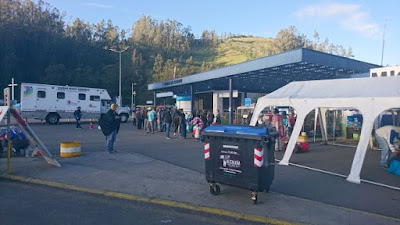Heavy mist and cloud greeted me as the curtains were drawn in Huari at 7.30am, Tuesday. It is to be expected in a mountain town situated at over 10,000ft. Patience pays. By 9.30 the mist was lifting, peeks of blue sky suggested a nicer day ahead. The wheels started rolling at 10.
I was overly pessimistic in my attire and needed to stop to remove a layer while transiting the well paved valley road. After 30 miles the climb to cross the Cordillera Negro began in earnest. The range acquired this name as the mountains are not as high, snow not nearly as prevalent. Still, an altitude of 14,500ft at the continental divide is not too shabby. A cold rain fell on the Atlantic side and required putting the layer back on. Emerging from the tunnel on the Pacific side the road was dry, only a few spots of precipitation hit the visor. The chill remained.
As has frequently been the case each side of the mountain range has different weather. It is always nicer to go from wet to dry.
Rain returned as I entered Huaraz, home for the night and another town at over 10,000ft. The hotels are not heated and it gets cold at night at these altitudes. Under Armour cold gear makes great sleep wear!
Rain returned as I entered Huaraz, home for the night and another town at over 10,000ft. The hotels are not heated and it gets cold at night at these altitudes. Under Armour cold gear makes great sleep wear!
Many of the towns in the Andes have had a pulse, a few have not; Huaraz has a heartbeat. Bigger in size and a 'hot' tourist town for adventurers in the northern hemisphere summer, the town has a raft of restaurants serving more than fried food with rice. Cerviche took my fancy, it was a pleasant change of pace.
The Cordillera Negro in a video collage.
T2

























































